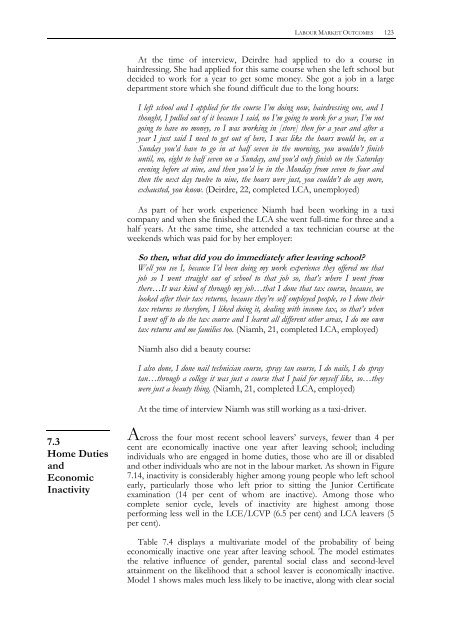Student Experiences of the Leaving Certificate Applied Programme
Student Experiences of the Leaving Certificate Applied Programme
Student Experiences of the Leaving Certificate Applied Programme
You also want an ePaper? Increase the reach of your titles
YUMPU automatically turns print PDFs into web optimized ePapers that Google loves.
LABOUR MARKET OUTCOMES 123At <strong>the</strong> time <strong>of</strong> interview, Deirdre had applied to do a course inhairdressing. She had applied for this same course when she left school butdecided to work for a year to get some money. She got a job in a largedepartment store which she found difficult due to <strong>the</strong> long hours:I left school and I applied for <strong>the</strong> course I’m doing now, hairdressing one, and Ithought, I pulled out <strong>of</strong> it because I said, no I’m going to work for a year, I’m notgoing to have no money, so I was working in [store] <strong>the</strong>n for a year and after ayear I just said I need to get out <strong>of</strong> here, I was like <strong>the</strong> hours would be, on aSunday you’d have to go in at half seven in <strong>the</strong> morning, you wouldn’t finishuntil, no, eight to half seven on a Sunday, and you’d only finish on <strong>the</strong> Saturdayevening before at nine, and <strong>the</strong>n you’d be in <strong>the</strong> Monday from seven to four and<strong>the</strong>n <strong>the</strong> next day twelve to nine, <strong>the</strong> hours were just, you couldn’t do any more,exhausted, you know. (Deirdre, 22, completed LCA, unemployed)As part <strong>of</strong> her work experience Niamh had been working in a taxicompany and when she finished <strong>the</strong> LCA she went full-time for three and ahalf years. At <strong>the</strong> same time, she attended a tax technician course at <strong>the</strong>weekends which was paid for by her employer:So <strong>the</strong>n, what did you do immediately after leaving school?Well you see I, because I’d been doing my work experience <strong>the</strong>y <strong>of</strong>fered me thatjob so I went straight out <strong>of</strong> school to that job so, that’s where I went from<strong>the</strong>re…It was kind <strong>of</strong> through my job…that I done that tax course, because, welooked after <strong>the</strong>ir tax returns, because <strong>the</strong>y’re self employed people, so I done <strong>the</strong>irtax returns so <strong>the</strong>refore, I liked doing it, dealing with income tax, so that’s whenI went <strong>of</strong>f to do <strong>the</strong> tax course and I learnt all different o<strong>the</strong>r areas, I do me owntax returns and me families too. (Niamh, 21, completed LCA, employed)Niamh also did a beauty course:I also done, I done nail technician course, spray tan course, I do nails, I do spraytan…through a college it was just a course that I paid for myself like, so…<strong>the</strong>ywere just a beauty thing. (Niamh, 21, completed LCA, employed)At <strong>the</strong> time <strong>of</strong> interview Niamh was still working as a taxi-driver.7.3Home DutiesandEconomicInactivityAcross <strong>the</strong> four most recent school leavers’ surveys, fewer than 4 percent are economically inactive one year after leaving school; includingindividuals who are engaged in home duties, those who are ill or disabledand o<strong>the</strong>r individuals who are not in <strong>the</strong> labour market. As shown in Figure7.14, inactivity is considerably higher among young people who left schoolearly, particularly those who left prior to sitting <strong>the</strong> Junior <strong>Certificate</strong>examination (14 per cent <strong>of</strong> whom are inactive). Among those whocomplete senior cycle, levels <strong>of</strong> inactivity are highest among thoseperforming less well in <strong>the</strong> LCE/LCVP (6.5 per cent) and LCA leavers (5per cent).Table 7.4 displays a multivariate model <strong>of</strong> <strong>the</strong> probability <strong>of</strong> beingeconomically inactive one year after leaving school. The model estimates<strong>the</strong> relative influence <strong>of</strong> gender, parental social class and second-levelattainment on <strong>the</strong> likelihood that a school leaver is economically inactive.Model 1 shows males much less likely to be inactive, along with clear social

















